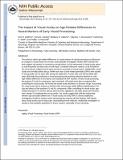| dc.contributor.author | Daffner, Kirk R. | |
| dc.contributor.author | Haring, Anna E. | |
| dc.contributor.author | Alperin, Brittany R. | |
| dc.contributor.author | Zhuravleva, Tatyana Y. | |
| dc.contributor.author | Mott, Katherine K. | |
| dc.contributor.author | Holcomb, Phillip J. | |
| dc.date.accessioned | 2017-04-26T18:50:15Z | |
| dc.date.issued | 2013 | |
| dc.identifier | Quick submit: 2014-06-05T15:13:55-04:00 | |
| dc.identifier.citation | Daffner, Kirk R., Anna E. Haring, Brittany R. Alperin, Tatyana Y. Zhuravleva, Katherine K. Mott, and Phillip J. Holcomb. 2013. “The Impact of Visual Acuity on Age-Related Differences in Neural Markers of Early Visual Processing.” NeuroImage 67 (February): 127–136. doi:10.1016/j.neuroimage.2012.10.089. | en_US |
| dc.identifier.issn | 1053-8119 | en_US |
| dc.identifier.uri | http://nrs.harvard.edu/urn-3:HUL.InstRepos:32536972 | |
| dc.description.abstract | The extent to which age-related differences in neural markers of visual processing are influenced by changes in visual acuity has not been systematically investigated. Studies often indicate that their subjects had normal or corrected-to-normal vision, but the assessment of visual acuity seems to most frequently be based only on self-report. Consistent with prior research, to be included in the current study, subjects had to report normal or corrected-to-normal vision. Additionally, visual acuity was formally tested using a Snellen eye chart. Event-related potentials (ERPs) were studied in young adults (18–32 years old), young–old adults (65–79 years old), and old–old adults (80 + years old) while they performed a visual processing task involving selective attention to color. Age-related differences in the latency and amplitude of ERP markers of early visual processing, the posterior P1 and N1 components, were examined. All results were then re-analyzed after controlling for visual acuity. We found that visual acuity declined as a function of age. Accounting for visual acuity had an impact on whether older and younger adults differed significantly in the size and latency of the posterior P1 and N1 components. After controlling for visual acuity, age-related increases in P1 and N1 latency did not remain significant, and older adults were found to have a larger P1 amplitude than young adults. Our results suggest that until the relationship between age-associated differences in visual acuity and early ERPs is clearly established, investigators should be cautious when interpreting the meaning of their findings. Self-reports about visual acuity may be inaccurate, necessitating formal measures. Additional investigation is needed to help establish guidelines for future research, especially of very old adults. | en_US |
| dc.language.iso | en_US | en_US |
| dc.publisher | Elsevier BV | en_US |
| dc.relation.isversionof | 10.1016/j.neuroimage.2012.10.089 | en_US |
| dc.relation.hasversion | https://www.ncbi.nlm.nih.gov/pmc/articles/PMC3545036/ | en_US |
| dash.license | LAA | |
| dc.subject | Aging | en_US |
| dc.subject | Visual processing | en_US |
| dc.subject | Visual acuity | en_US |
| dc.subject | ERPs | en_US |
| dc.title | The impact of visual acuity on age-related differences in neural markers of early visual processing | en_US |
| dc.type | Journal Article | en_US |
| dc.date.updated | 2014-06-05T19:13:55Z | |
| dc.description.version | Accepted Manuscript | en_US |
| dc.rights.holder | Daffner, K. R. Haring, A. E. Alperin, B. R. Zhuravleva, T. Y. Mott, K. K. Holcomb, P. J. | |
| dc.relation.journal | NeuroImage | en_US |
| dash.depositing.author | Daffner, Kirk R. | |
| dc.date.available | 2017-04-26T18:50:15Z | |
| dc.identifier.doi | 10.1016/j.neuroimage.2012.10.089 | * |
| dash.contributor.affiliated | Daffner, Kirk | |


